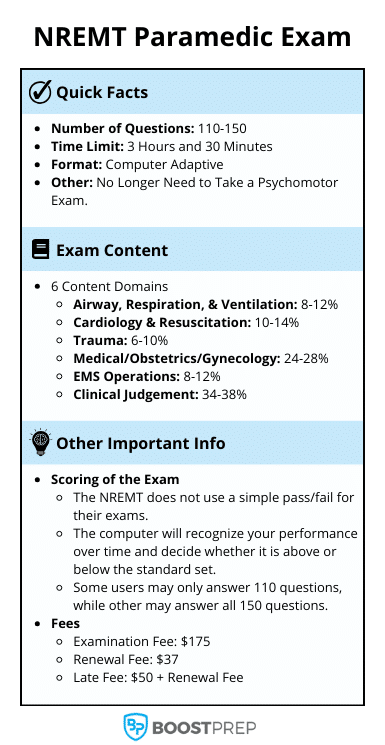Take our free paramedic practice test below to see if you are ready for the actual exam.
Instantly find out if you are ready for the NREMT paramedic exam.
Exam Summary
0 of 30 Questions completed
Questions:
Information
You have already completed the exam before. Hence you can not start it again.
Exam is loading…
You must sign in or sign up to start the exam.
You must first complete the following:
Results
Results
Your time:
Time has elapsed
You have reached 0 of 0 point(s), (0)
Earned Point(s): 0 of 0, (0)
0 Essay(s) Pending (Possible Point(s): 0)
Categories
- Airway, Respiration, and Ventilation 0%
- Cardiology and Resuscitation 0%
- Clinical Judgement 0%
- EMS Operations 0%
- Medical; Obstetrics & Gynecology 0%
- Trauma 0%
-
Keep Studying: You will not pass the NREMT paramedic exam right now. You need to continue studying for the exam. Take some of our full-length practice exams.
-
Almost There: We recommend that you keep studying. You may be able to pass the NREMT paramedic exam right now, but it will be close. Take some of our full-length practice exams.
-
You Are Ready: We feel you are ready for the NREMT paramedic exam. You can continue to study if you would like to be safe. Take some of our full-length practice exams.
- 1
- 2
- 3
- 4
- 5
- 6
- 7
- 8
- 9
- 10
- 11
- 12
- 13
- 14
- 15
- 16
- 17
- 18
- 19
- 20
- 21
- 22
- 23
- 24
- 25
- 26
- 27
- 28
- 29
- 30
- Current
- Review
- Answered
- Correct
- Incorrect
-
Question 1 of 30
1. Question
CorrectIncorrect -
Question 2 of 30
2. Question
CorrectIncorrect -
Question 3 of 30
3. Question
CorrectIncorrect -
Question 4 of 30
4. Question
CorrectIncorrect -
Question 5 of 30
5. Question
CorrectIncorrect -
Question 6 of 30
6. Question
CorrectIncorrect -
Question 7 of 30
7. Question
CorrectIncorrect -
Question 8 of 30
8. Question
CorrectIncorrect -
Question 9 of 30
9. Question
CorrectIncorrect -
Question 10 of 30
10. Question
CorrectIncorrect -
Question 11 of 30
11. Question
CorrectIncorrect -
Question 12 of 30
12. Question
CorrectIncorrect -
Question 13 of 30
13. Question
CorrectIncorrect -
Question 14 of 30
14. Question
CorrectIncorrect -
Question 15 of 30
15. Question
CorrectIncorrect -
Question 16 of 30
16. Question
CorrectIncorrect -
Question 17 of 30
17. Question
CorrectIncorrect -
Question 18 of 30
18. Question
CorrectIncorrect -
Question 19 of 30
19. Question
CorrectIncorrect -
Question 20 of 30
20. Question
CorrectIncorrect -
Question 21 of 30
21. Question
CorrectIncorrect -
Question 22 of 30
22. Question
CorrectIncorrect -
Question 23 of 30
23. Question
CorrectIncorrect -
Question 24 of 30
24. Question
CorrectIncorrect -
Question 25 of 30
25. Question
CorrectIncorrect -
Question 26 of 30
26. Question
CorrectIncorrect -
Question 27 of 30
27. Question
CorrectIncorrect -
Question 28 of 30
28. Question
CorrectIncorrect -
Question 29 of 30
29. Question
CorrectIncorrect -
Question 30 of 30
30. Question
CorrectIncorrect
Other Related Practice Tests
If you want to practice for another certification exam, here are our other certification practice exams:
Pass Your NREMT Exam. Guaranteed.
Paramedic Exam Prep
- 10 Full-Length Practice Tests
- 1,200+ Practice Questions
- 100% Pass Guarantee
"Very helpful, thanks so much for your product. I did not realize how much I needed this. Thanks again..."
NREMT Paramedic Test Overview
The Paramedic test is a standardized exam given by the National Registry of Emergency Medical Technicians (NREMT). Here is what you can expect to find on your NREMT paramedic exam:
- Number of Questions: 110-150
- Time Limit: 3 Hours and 30 Minutes
- Format: Computer Adaptive
There are 6 content domains covered on the exam:
| Content Domain | Percent of Examination |
|---|---|
| Airway, Respiration & Ventilation | 8% – 12% |
| Cardiology & Resuscitation | 10% – 14% |
| Trauma | 6% – 10% |
| Medical/Obstetrics/Gynecology | 24% – 28% |
| EMS Operations | 8% – 12% |
| Clinical Judgment | 34% – 38% |
Note: The psychomotor exam has been discontinued. Individuals only have to complete the cognitive exam now (listed above).
Types of Paramedic Questions
There will be a total of 110-150 questions on the paramedic exam. Here are the types of paramedic test questions you can expect:
- Multiple-Choice: Standard multiple-choice questions that have 1 correct answer.
- Multiple-Response: Questions that have multiple correct answers (typically 2 or 3).
- Build Lists: Questions that ask you to order content according to the instructions given to you.
- Drag-and-Drop: Questions that require you to drag the answer and drop it into the appropriate box.
- Option/Check Box: Questions that ask you to work your way down a list and select if something is relevant or not.
- Graphical: Questions that provide information in graphical format. These can be any of the above types of questions.
- Scenario-Based: Questions that provide a scenario or reading passage. These can be any of the above types of questions.
Practice for the Paramedic Exam with the Right Tools
1. Question Banks
Question banks are a great tool to prepare for the paramedic exam. Our question banks let you prepare for the specific content domains listed above.
This allows you to pinpoint your studies on problem areas, which saves you study time in the long-run.
2. Full-Length Exams
Full-length exams are another great tool you should be taking advantage of. Full-length exams should have the following:
- Time limit
- Same number of questions as actual exam
- Same types of questions as actual exam
Our full-length exams have all of the above and do a great job of simulating the actual exam.
3. Flashcards
Flashcards are a super efficient way to prepare for your exam. Flashcards can help you memorize important concepts and provide a quick way to review things.
Our flashcards have a feature to “speed study”. This means you can quickly review all of the terms without flipping through each flashcard (if you would like).
All of the above tools can be found in our online paramedic prep course.
Tips and Tricks for Paramedic Prep
Preparing for the NREMT paramedic exam can be a daunting task. Here are some tips and tricks to keep you on tracks:
- Determine Where You Stand: Take our paramedic practice test above to determine your baseline. If you do well, great! If you struggle, consider your prep options.
- Utilize Full-Length Exams: Full-length exams are your friend. These exams will help you nail down your timing, become more familiar with the exam, and learn important concepts.
- Answer Explanations: Make sure to review all answer explanations after completing your exams. These answer explanations can help you learn key concepts.
If you are preparing for another certification level, visit our NREMT practice exam page for more exams.
Frequently Asked Questions
There will be between 110 and 150 total questions on the paramedic exam.
The number of questions will vary depending on how you are doing since the exam is computer adaptive.
You will be given 3 hours and 30 minutes.
According to the NREMT Paramedic Candidate Handbook, the decision regarding passing or failing the exam is based on the following:
“Has the candidate reached the level of entry-level competency (passed) or has the candidate not yet reached entry-level competency (failed)?”
Essentially this means that there is no technical “passing score.” You will continue to answer questions until the system determines you have an acceptable level of competency (passed).
You will have 6 chances to pass the exam. You will need to wait 15 days between each attempt.
After 3 unsuccessful attempts, you will need to submit proof of completion of a remedial training program.
You will need to pay a fee of $175 to take the exam. This fee applies for each exam attempt, so make sure you are properly prepared the first time to avoid having to pay the fee again to retest.



